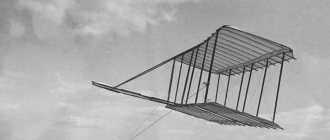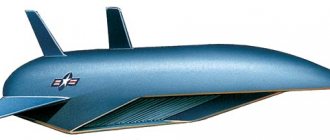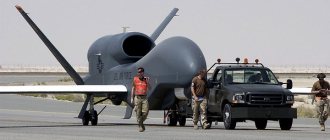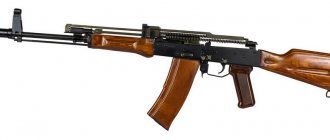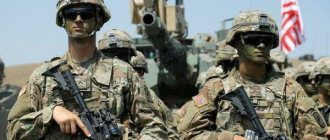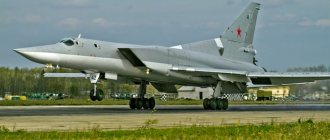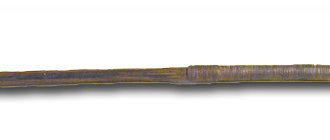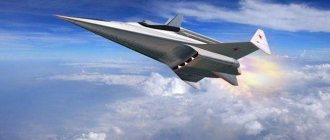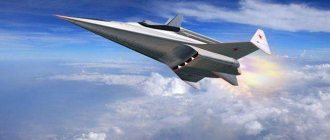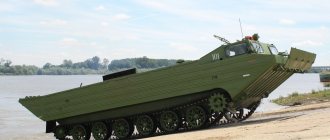The intense competition that exists between states in the field of military technology leads to the rapid obsolescence of military vehicles. Therefore, the period of maintenance of military aircraft in service is quite short.
First of all, this problem applies to fighters designed to counter the latest enemy models. But everywhere there are exceptions. The MiG-21 aircraft, a brilliant achievement of Soviet designers, was supplied to the aviation fleet of the USSR and other countries for more than a quarter of a century.
History of creation
The Soviet MiG-15 fighter, which showed itself to be a formidable weapon in Korea, greatly upset American pilots and the US leadership, dispelling the idea of the backwardness of Soviet aviation. In the current situation, the geopolitical enemy of the USSR urgently needed a machine that could surpass Soviet aircraft in its combat characteristics.
In 1954, the world's first fighter, the speed of which exceeded sound speed by 2 times, the Lockheed F-104 Starfighter, took off into the airspace.
The Russians' goal was to counter the Americans with an aircraft capable of intercepting high-speed bombers and destroying enemy attack aircraft.
In the early 60s, in accordance with the Resolution of the Council of Ministers of the USSR, design bureaus began to work on the creation of a fundamentally new type of machine - a supersonic attack aircraft.
The design bureaus of A. Yakovlev, P. Sukhoi, A. Mikoyan and M. Gurevich were involved in the process; they all worked on separate projects.
Yakovlev presented the Yak-140 - a light fighter, distinguished by good thrust-to-weight ratio and great maneuverability in the vertical and horizontal planes.
Having relied on maneuverability, the designers had to sacrifice speed. This decided the fate of the project: it was rejected.
The SU-7, developed by a group led by Sukhoi, was put into production and produced from 1957 to 1960. It had the following characteristics:
- Thrust-to-weight ratio max: 3900 kgf: 7370 kg = 058 (afterburner mode - 0.78);
- Wing load = 7370 kg: 23 sq.m. = 320 kg/sq.m;
- Maximum speed – 2170 km/s;
- Maximum height – 19100 m;
- Good maneuverability, which follows from the parameters of thrust-to-weight ratio and specific wing load.
But due to significant flaws in the design of the machines, they often failed. In 1957, in accordance with the directives of the management, the Su-7 began to be converted into a fighter-bomber - the Su-7B (product S-22).
However, the MiG-21 was chosen as the front-line fighter, which later became the most popular attack aircraft in the history of the country. It was easier to operate, more economical in terms of fuel consumption, and less noticeable in the air. Its takeoff and landing characteristics exceeded those of the Su-7.
Russian Aviation
In the mid-1950s, jet aircraft began to take a leading position in the skies. The planes reached the speed of sound. The first to do this was on October 14, 1947, by pilot Charles Elwood Yeager on the X-1 experimental aircraft, created by Bell under a joint order of the US Air Force and the civilian agency NACA (since 1958 - NASA). The X-1 was lifted to an altitude of 10 km in the bomb bay of a B-29 bomber. After separation from the carrier aircraft, the X‑1 was accelerated by an XLR‑11 rocket engine. At an altitude of 13,700 m, a speed of Mach 1.06 was achieved. The X‑1 device had a straight wing. Due to the secrecy regime, the message about Yeager's record flight appeared in the press only on December 22, 1947.
There is a version that Yeager was not the first to exceed the speed of sound. Two weeks earlier, on October 1, military test pilot George Welch performed the first flight on the North American XP-86 aircraft, the prototype of the first American swept-wing fighter jet, the F-86 Saber. During the flight, the front landing gear jammed, and in order to release it, Welch began to perform a high-speed dive. At the same time, he reported that the arrows of the speed and altitude indicators fluctuated unusually, going beyond the limit values. The XP-86's on-board instruments were not designed for speeds greater than Mach 1, so there is no certainty that Welch would exceed the sound barrier on the October 1 flight. This version was expressed by his fellow tester Al Blackburn in his book of memoirs in 1998; Welch himself died on October 12, 1954, when he tried to accelerate the F‑100A‑1NA fighter to a speed of Mach 1.55 at 7 times overload.
The speed of sound was first achieved in the Soviet Union a year after the success of the X-1, on December 26, 1948. This was done by test pilot Oleg Sokolovsky on the La-176 experimental jet aircraft developed by OKB-301 under the leadership of Semyon Lavochkin. The car had a fuselage from the previous experimental jet La-168, a new swept wing with an angle of 45° and a thin profile.
Sokolovsky took off from the Novofedorovka (Saki) airfield in Crimea, rose to an altitude of 10,000 m and put the car into a gentle descent. At an altitude of 6,000 m, La-176 was transferred to horizontal flight. But before that, a speed of 1,105 km/h (Mach 1.02) was recorded at an altitude of 7,000 m. In January 1949, Sokolovsky and his partner, test pilot Ivan Fedorov, reached the speed of sound five more times on the La-176. This is how Fedorov talked about these flights in his memoirs: “I accelerate my 176th from a great height.” A tedious low whistle is heard. Increasing speed, the plane rushes towards the ground. On the meter scale, the needle moves from three-digit numbers to four-digit numbers. The plane is shaking as if in a fever. And suddenly - silence! The sound barrier has been taken." However, on February 3, 1949, Oleg Sokolovsky did not close the cockpit canopy lock before the next flight. The canopy was torn off during takeoff. The pilot, trying to hold it with one hand, pulled the control stick towards himself with the other hand. The plane lifted its nose, lost speed, fell over and crashed into the ground. Sokolovsky died. Work on the La-176 project was stopped and the vehicle did not go into production.
The first of the serial fighters, and not experimental machines, that reached the speed of sound was the Soviet jet fighter MiG-17, developed in the late 1940s at OKB-155, the leaders of which from the moment of its formation were chief designer Artem Ivanovich Mikoyan and deputy chief designer Mikhail Iosifovich Gurevich. The first flight of the prototype took place on January 14, 1950. Military pilots knew that it could accelerate to the speed of sound and faster, but officially the MiG-17, like the American F-86, was considered transonic.
The first mass-produced supersonic aircraft were the Soviet MiG-19 developed by OKB-155 and the American F-100 from North American, which appeared in the skies almost simultaneously.
The MiG-19 was put into production in a fairly large series. However, at that time, OKB-155 was already working on a project for an even faster single-seat front-line fighter, which was initially conceived as a modernization of the MiG-19. Mikoyan sent a proposal for its development to the Minister of Aviation Industry Pyotr Dementyev in the summer of 1953. Mikoyan was aware of the work at the engine-building OKB-300, headed by Alexander Mikulin: a new powerful AM-11 engine was being created there with a maximum thrust of 4000 kgf, and with afterburner - 5000 kgf. After Mikulin’s dismissal in January 1955, Sergei Tumansky, who replaced him, renamed this engine R-11-300.
Mikoyan suggested that Dementyev build a fighter with one AM-11 and a delta wing. On September 9, 1953, a Resolution of the USSR Council of Ministers was issued, according to which it was to be a light supersonic front-line fighter with a delta wing and one AM-11 engine. Compared to the MiG-19, equipped with two AM-9B engines (since 1955 - RD-9B), a new aircraft with one powerful engine with the same thrust-to-weight ratio would have an advantage in the weight of the structure, and the fuel consumption per sortie would be below.
“Triangular wings, having low resistance, provide a flight speed of about 1,700 - 2,000 km/h and, thanks to design advantages, make it possible to additionally place fuel in the wings, which increases the range and duration of the flight... Considering that the creation of an aircraft of a new design with a triangular wing is a further stage in the development of aviation technology, I ask you to consider the attached draft Resolution and submit it for consideration by the Council of Ministers of the USSR,” - from a letter from the Minister of Aviation Industry Pyotr Dementyev to the Minister of Defense of the USSR Nikolai Bulganin (1953).
Such projects of single-engine machines became possible with the beginning of the development of powerful bypass turbojet engines at the Soviet engine design bureau in the early 1950s. For example, three months before the decree providing for the creation of a new MiG fighter with a Mikulin engine, on June 3, 1953, a decree of the USSR Council of Ministers was issued on the creation of a front-line fighter I-3 (I-380) powered by a powerful VK-3 engine (developed by OKB-117, head - Vladimir Klimov) with a nominal thrust of 5,730 kgf and afterburner thrust of 8,440 kgf. However, due to the delay in the creation of the VK-3, although the experimental I-3 fighter was built, it never took off: when the engine was completed, anti-aircraft missiles began to be considered a more effective weapon against strategic bombers than fighters and interceptors.
OKB-300 also did not meet the deadlines for the creation of AM-11. Therefore, the first prototypes of the MiG-21 were equipped with the less powerful AM-9B with the MiG-19. But the AM-11 engine was not the only issue for Mikoyan’s new fighter. The triangular wing, specified in the resolution of the Council of Ministers of September 9, 1953, was also new to OKB-155. Therefore, they decided to build a new fighter in two versions - with a new delta wing and with an already well-developed swept wing. To select the final version, it was supposed to compare the results of flight tests of two prototypes. The first delta-wing prototype, developed in mid-1954, was called the E-1. It was initially planned to be equipped with an AM-5 engine, which after modernization became known as AM-9. However, E-1 never left the project stage. The development of the delta wing required more time and additional research.
The same problems were encountered in 1954 at OKB-51, headed by Pavel Sukhoi, when developing the T-1 front-line fighter and T-3 interceptor, also equipped with a delta wing. The swept wing was well developed at OKB-155. Therefore, the E-2 prototype with a swept wing was the first to be ready for flight testing. Its assembly was completed on December 25, 1954, after which the prototype was transported to Zhukovsky for testing.
“They began to make swept wings so that at transonic flight speeds the air resistance would not increase so much and the balance would not be disturbed,” writes Hero of the Soviet Union, Lieutenant General of Aviation, Honored Test Pilot of the USSR in his book “Memoirs of a Military Test Pilot” Stepan Mikoyan (nephew of Artem Mikoyan). “However, at high angles of attack, that is, at low speeds or when maneuvering, a swept wing creates more air resistance than a conventional wing with the same lift force, which means its aerodynamic quality is lower. This leads to a decrease in flight range and deterioration in maneuverability. On landing, at the same angle of inclination of the fuselage, which is limited by the possibility of the tail touching the ground, the lifting force of a swept wing is less than that of a straight wing, so the landing speed is higher. So for low and medium speeds, as well as for takeoff and landing, a non-swept wing is much more advantageous.”
E-2A prototype
American engineer and physicist Theodore von Karman in the book “Aerodynamics. Selected Topics in Their Historical Development" reveals that swept wings, the leading edges of which form a significant angle relative to the perpendicular to the direction of flight, have become an effective method of delaying interference at high Mach numbers. “The structure of the flow relative to the wing is determined by the “effective Mach number,” corresponding to the component of flight speed perpendicular to the span,” writes von Karman. “If, for example, the swept angle is 45°, then the effective Mach number is approximately 70% of the flight Mach number, so the critical value of the latter, where transonic interference appears, will increase by almost 40%.”
The Germans were the first to come close to the practical use of swept wings. Physicist Albert Betz was the first to suggest that sweep could be useful in delaying transonic effects in flight at high Mach numbers. During World War II, Betz, who served as director of the Aerodynamics Laboratory in Göttingen, developed a swept wing for Messerschmidt and tested it in a wind tunnel. The German interceptor Messerschmitt Me 163, equipped with a rocket engine, had a swept wing with a leading edge sweep angle of 26°, which made its first powered takeoff on August 10, 1941. In October 1945, a very similar aircraft, the de Havilland DH 108, was developed in Great Britain, which had a swept wing with an angle of 43°, but was equipped, however, with a turbojet engine. It made its first flight on May 15, 1946.
Independently of German and British aerodynamicists during the Great Patriotic War, the young candidate of technical sciences Vladimir Struminsky from TsAGI developed the theory of a three-dimensional boundary layer and the vortex theory of the wing. The theory subsequently laid the foundations for the general principles of the aerodynamic layout of swept and delta wings. Struminsky's research played a significant role in breaking the sound barrier and achieving supersonic flight speeds. To confirm the results of Struminsky’s research, models were purged in TsAGI wind tunnels, on the basis of which the design bureau issued recommendations on the aerodynamic layout of swept wings.
The first experimental swept-wing jet fighter was the La-160, built at OKB-301, headed by Lavochkin. It flew on June 11, 1947. The first American experimental swept-wing fighter, the XP-86, as already mentioned, flew only three and a half months later - October 1, 1947.
La-160
However, La-160 remained in a single copy. The first serial Soviet turbojet fighter I-300 (MiG-9) developed by OKB-155, which took off on April 24, 1946, was an all-metal mid-wing with a straight wing. However, for the I‑310 (MiG‑15) that replaced it, OKB‑155, together with TsAGI, developed a swept wing with a sweep angle along the leading edge of 37° and with a relative thickness of 10% at the root of the wing. The results of experimental studies of aerodynamic models and flight tests of the La-160 allowed TsAGI to develop recommendations for OKB-155 designers.
After the MiG-15, OKB-155 created new fighter designs with swept wings, including the MiG-17 (the wing received a double sweep: from the side rib to the half-span - 45˚, and then - 42˚) and MiG-19 (angle sweep along 1/4 of the chord line - 55°). It was initially decided to use the wing with the MiG-19 profile on the new E-2 prototype.
On February 14, 1955, at the airfield of the Flight Research Institute (now the M.M. Gromov Flight Research Institute), OKB-155 test pilot Georgy Mosolov first flew the E-2 prototype aircraft with a swept wing.
E-2 prototype
Due to a delay in fine-tuning the AM-11 engine, the first flights of the E-2 were carried out with the AM-9B engine with a thrust of 3,250 kgf. Its thrust was enough to test handling and work out aerodynamics. Naturally, AM-9B did not allow reaching the design speed of 1,950 km/h. Therefore, it was decided to postpone the removal of the main flight characteristics of the E-2 until the appearance of the AM-11. The used standard engine, renamed R‑11–300, was ready by the end of 1955. The modified aircraft was named E-2A. Its fuselage was a hybrid of the E-2 design and the delta-wing E-5 prototype. The E-2A wing itself is close to the swept wing of the E-2, but without automatic slats and with large partitions. On February 17, 1956, the first flight with the new engine was performed by OKB-155 senior test pilot Grigory Sedov. Even before this, in the second half of November 1955, production of the second prototype E-2A/2 began. Its assembly was completed on July 28, 1956, and its first flight took place on September 4 of the same year. And Sedov lifted this car into the sky.
Testing the E-2A was very difficult. Flights had to be repeatedly interrupted due to unsatisfactory performance and frequent replacement of new R-11-300 engines. The car was characterized by longitudinal rocking and increased sensitivity to small deviations of the roll control stick at high speeds. In addition, it was necessary to deal with shaking, detected when flying at high speed at low altitudes, and with lateral rocking. Although the E-2A managed to reach a design speed of 1950 km/h, it revealed an unpleasant feature of the highly swept wing - at high angles of attack the plane spontaneously lifted its nose until the wing’s load-bearing properties were completely lost and fell into a tailspin. To prevent this phenomenon, large aerodynamic ridges were installed on the E‑2A wing, preventing the flow of air from the root to the tips, and in this way it immediately differed in appearance from a simple E‑2.
On December 31, 1957, E-2A/2 was submitted for state testing. A total of 107 flights were performed on this prototype in 1956–1957 (and taking into account the E-2A/1 - 165 flights). All the main characteristics were removed from them. During tests on the E-2A (flight weight 6250 kg), a maximum speed of 1950 km/h (Mach 1.78), a ceiling of 18000 m, and a range of 2000 km were achieved. The vehicle reached an altitude of 10,000 m in 1 minute 18 seconds.
E-4 prototype with delta wing. During the tests, three ridges on the upper surface of the wing (1, 4) were replaced by two on the lower surface (2, 3).
On June 16, 1955, at the LII airfield in Zhukovsky, senior test pilot OKB-155 Grigory Sedov first flew the E-4 prototype aircraft with a delta wing.
The design of the E-4 was based on the airframe of the E-2 aircraft: the fuselage and tail were similar. Initially, the prototype had a pure delta wing with a leading edge sweep of 57°, but with aerodynamic baffles - one each on the lower surfaces of the consoles, approximately in the middle. Due to the fact that the flightable R-11-300 would appear only by the end of 1955, the “half-sized” RD-9E with a thrust of 3,800 kgf was first installed on the E-4. With its help, the E-4 could only accelerate to 1,290 km/h. Therefore, flights of the E-4, like the E-2, were used mainly to evaluate aerodynamics and controllability. The OKB and TsAGI, apparently, did not yet clearly understand the flow pattern around a delta wing, so they used a simple “trial and error” method. The plane became, in essence, an aerodynamic flying laboratory. Based on the results of the first flights, three vertical ridges were installed on the upper surface of each plane of the E-4 delta wing, two of which protruded beyond the edge of the wing. The shape of the wing tips was changed, and a small air intake was removed from the gargrot. Then the three upper ridges were replaced by two on the lower surface, while increasing the span due to the pointed ends of the wing. The E-4 also determined the minimum flight speed, spin characteristics, and aerodynamic forces acting on the canopy.
The first flights of the E-4 brought another problem. The plane was underspeeding compared to the calculated speed, which indicated some kind of additional aerodynamic resistance, which was eating up the engine power to no avail. This mysterious resistance was found relatively quickly. The phenomenon that gave rise to it was called the bottom effect. The fuselage of an aircraft with a jet engine, through which air is continuously forced during flight, can be compared to a pipe. If the edges of the exhaust nozzle coincided with the edges of the “bottom” (fuselage rear), there would be no question of any bottom or stern effect. But the diameter of the nozzle was smaller than the diameter of the stern. This resulted in suction and turbulence of air flowing down from the fuselage, and as a result, an increase in resistance. It took a while to cope with the new phenomenon, but then the ability to reduce the bottom effect became firmly established in the practice of supersonic aviation.”
In total, until September 20, 1956, the E-4 completed 109 test flights. After the engine and equipment had completely exhausted their service life, the E‑4 was written off. But even before that, as soon as the flightable P-11-300 appeared, work began at plant No. 155 on a new prototype called E-5. Its assembly was completed on December 10, 1955. A month before the E-2A, on January 9, 1956, the E-5 made its first flight. The plane was piloted by OKB-155 test pilot Vladimir Nefedov.
The E-5 with the R-11-300 flew 700 km/h faster than the E-4 with the RD-9E. However, a month later, on February 20, during ground testing, the R-11-300 engine caught fire and its turbine was destroyed. The plane was returned to plant No. 155 and repaired. The next time he took to the skies was only on March 26. On March 30, a speed of 1,810 km/h was reached at an altitude of 10,500 m, and on May 19, at an altitude of 11,000 m - 1,960 km/h (Mach 1.85). However, the R-11-300 was still far from ideal reliability: due to another fire during a ground race, the turbine was destroyed again, flight tests stopped, and on October 27, the E-5 was back on the factory floor. Here, at the same time, they modernized it: they lengthened the forward part of the fuselage by 40 cm. This was required in connection with the installation of the R-11-300 engine with an expanded pre-chamber, due to which the center of mass shifted back by 5%. In addition, the capacity of the internal fuel tanks was increased by 240 liters, bringing them to 1,810 liters.
On April 1, 1957, E-5 returned to LII. Until May 26, he completed 13 more flights, completing factory flight tests.
The desire to reduce the mass and increase the rigidity of the wing forces us to reduce its aspect ratio and increase its taper. This tendency, combined with a large sweep angle, leads to a triangular wing shape. Triangular wings with a sweep angle of 55–70° have found practical application.
“The delta wing retains the advantages of a large swept wing and has additional advantages due to its low relative thickness,” writes Theodor von Karman. — The small relative thickness of the central part is maintained due to the use of large chord lengths. The large chord allows for a relatively large capacity within the wing, which can be used as a reservoir for fuel or other cargo. Moreover, one important feature of the triangular shape is that the displacement of the center of pressure during the transition from subsonic to supersonic flight is less than with conventional shapes. Most delta wing aircraft have only vertical stabilizers. The delta wing can be made longitudinally stable without a horizontal stabilizer, and the elevators and ailerons can be placed on the trailing edge of the wing."
A delta wing has almost the same aerodynamic characteristics as a swept wing, but it is free from some of the disadvantages of the latter. The delta wing is stiffer and lighter than both straight and swept wings. The disadvantage of the “triangle”, like the “arrow”, was the dependence of the aerodynamic characteristics on the flight speed. In addition, a delta wing is characterized by slightly higher drag and a sharper drop in maximum lift-to-drag ratio when the angle of attack changes. The advantages of a delta wing are best demonstrated at high, supersonic flight speeds. In total, the “triangle” promised increased speed, reduced weight, increased range, and maneuverability. It was all really worth fighting for.
The first experimental vehicles with a delta wing appeared in the 1930s. They were subsonic, and the wing profile was relatively thick. In 1937, under the leadership of designer Alexander Moskalev, the experimental aircraft SAM-9 “Strela” with a delta wing was built and successfully flown at the Voronezh aircraft plant No. 18. At that time, many engineers and pilots were wary of such unusual-looking devices.
Lippisch DM‑1
During World War II, German designer Alexander Lippisch conducted research on low aspect ratio wings in supersonic wind tunnels. Based on the data obtained, he developed a project for a high-speed or even supersonic interceptor aircraft, the Lippisch P. 13a, with a thick delta wing. To test its design, the Lippisch DM‑1 glider with the same wing was built in 1944. Lippisch did not have time to test it - Germany capitulated. The glider was transported to the USA, where it was tested.
After the war, the British developed several subsonic delta-wing jets. The first of these was the Avro 707 prototype, which flew on September 4, 1949. It was followed by the Gloster Javelin fighter (November 26, 1951) and the Avro Vulcan strategic bomber (first flight August 30, 1952).
The development of the first near- and supersonic jet aircraft with a thin delta wing began in the world at the turn of the 1950s, when there were no swept-wing fighters in operation: the first of them - the MiG-15 and F-86 - appeared later. These were the American fighter-interceptor F‑102 from Convair (a division of General Dynamics), which made its first flight on October 24, 1953, the American carrier-based fighter F‑4D from Douglas (October 3, 1953), as well as the French multirole fighter Mirage III. Dassault Aviation (November 17, 1956).
Test results for the E-2 and E-4 prototypes were mixed. There were no clear leaders in the “arrow” and “triangle” competition. Even seeing the prototypes standing next to each other, even comparing them in flight, it was difficult to make a clear choice.
In the first half of 1956, Mikoyan often traveled to the LII, where the next stage of the “batch” was unfolding - the E-2A and E-5 were flying in factory tests. Artem Ivanovich watched the test flights, talked with pilots, technicians, and design bureau engineers. But a very definite question arose: “Is it worth building serially aircraft with a new wing that has not yet been tested in production?”
Tests have shown that the E-2A with a swept wing, even with the R-11-300 engine, will not be able to accelerate to a speed of Mach 2. TsAGI specialists assured that this speed can only be achieved with a delta wing, which has better aerodynamic characteristics. Theoretically, it also provided a number of other significant advantages over the swept type. Yes, the delta wing has not been fully tested; it has only just left the laboratories and has barely begun to fly. But you need to bring its design to mind, and all the advantages will become obvious.
Mikoyan gathered pilots and the top management of the design bureau many times in his office. I listened to opinions. Even here, the pilots could not reasonably choose one of the two prototypes. The E-5 with its delta wing accelerated a little faster and flew faster, but this is understandable - it was a ton lighter than the swept-wing prototype. There was also an analysis of what was happening abroad.
Mikhail Arlazorov in his book “Artem Mikoyan” writes about this: “The Americans advertised the F-104 Starfighter with deafening noise. Its chief designer, Clarence Johnson from Lockheed, creator of the infamous U-2 spy plane, chose a straight wing for the Starfighter, seemingly completely banished from high-speed aviation, densely filling it with various kinds of flaps, slats, and flaps. Around the same time, the third high-speed fighter - Mirage III with a triangular wing, like the future MiG - began to be developed by the French designer Marcel Dassault. So who is right? The Americans or Dassault, whose position coincided with Mikoyan’s? All three fighters - American, Soviet and French - are aircraft of the same generation.
E-4 prototype
The Starfighter prototype appeared in 1954, the series - in 1957. E-4, the first incarnation of the MiG-21, built in 1955, series - in 1958. Mirage prototype - also in 1955, series - in 1961. Having examined the capabilities of an aircraft with a straight wing, Mikoyan did not believe in its prospects and ordered to continue work on a delta wing without slowing down.”
Mikoyan obviously reasoned: “Moscow was not built right away.” Artem Ivanovich quite rightly believed that the delta wing would be mastered over time and then reveal all its advantages. During state tests, the E-5 prototype proved to be successful: the calculated flight characteristics were confirmed, except for the flight range due to excessive engine fuel consumption. On June 11, 1956, a decree of the USSR Council of Ministers was issued on the introduction of the E-5 aircraft into a small series called MiG-21 (type 65). In 1957, the first five copies were built at plant No. 31 in Tbilisi.
MiG-21bis
Time has shown the correctness of Artem Ivanovich’s choice. “The MiG-21 aircraft is one of the most famous aircraft in the world,” writes Stepan Anastasovich Mikoyan in the book “Memoirs of a Military Test Pilot.” — From the beginning of production of the first production aircraft, it was produced in our country for almost thirty years, having undergone more than thirty modifications. Besides India, it was built in Czechoslovakia and China and was in service with about fifty countries. More MiG-21 aircraft have been built than any other type of fighter in the world.”
The choice made in 1956 by Artem Ivanovich Mikoyan is still valid. All supersonic aircraft are now equipped with a delta wing: the Su-35, the MiG-35, and the Su-57. And the MiG-21 fighter, created on the basis of the E-4 prototype, became the most popular supersonic fighter in the history of world aviation.
Konstantin Lantratov, UAC Horizons magazine / No. 2(26).2020 (abbreviated)
- 02/04/2016 MiG-19 - the first domestic serial supersonic fighter
- 12/08/2019 RSK MiG celebrates its 80th anniversary
- 03/30/2016 25 most outstanding aircraft in the history of domestic aviation
- 02/03/2016 Nizhny Novgorod Aircraft Manufacturing Plant
( 6 ratings, average: 5.00 out of 5)
Artyom MikoyanMiG-21Stepan Mikoyan
Prototypes for MiG-21
The time for close maneuver battles was ending. The attack aircraft was designed to conduct combat attacks when aircraft approach each other at enormous speeds and hit the target with the first missile salvo. The supersonic aircraft of the opponents, Lockheed F-104 in America and Mirage 3C in France, were designed using the same principle.
From the beginning of 1957, A. Brunov was appointed chief designer, who should manage the entire work process (design, construction, testing, finishing of experimental machines).
- E-1 - the first fighter model from the MiG-21 family had a swept wing. A separate engine was developed for it, but did not meet the deadline;
- E-2 is the second prototype with the AM-9B engine from the MiG-19 and a swept wing. Maximum speed 1700 km/h. The E-2A with the new engine accelerated to 1900 km/h;
- E-4 - this model was created simultaneously with E-2. The wing shape is triangular. Engine AM-9B. The sophisticated design of the multi-mode air intake allowed the vehicle to reach a speed of 700 km/h more than the MiG-19. Although in both cases the same engine model was used. The rationality of using a delta wing with a sweep of 57° along the leading edge was also proven by flight results. The maximum speed was 2000 km/h. In the course of further development, the vehicle was modified to version E-6. She reached speeds of up to Mach 2. The E-6 became the prototype of the production MiG-21.
MiG-21, design description
The aircraft is a single-seat mid-wing aircraft, equipped with one engine. Built according to a normal aerodynamic configuration, it has a low-lying delta wing (sweep 57° along the leading edge), all-moving horizontal tail (keel and rudder) with high sweep.
The wings are equipped with ailerons and flaps. Aerodynamic ridges to increase the lateral stability of the aircraft at high angles of attack. The wing consists of 2 consoles with one spar. The consoles have 2 fuel tanks.
In total, the fuel system, depending on the version of the car, included 12–13 tanks.
Fuselage type: semi-monocoque, i.e. part of the loads is carried by the fuselage, the other part of the loads is distributed to the load-bearing elements of the frame - stringers and frames. All-metal construction made of aluminum and magnesium alloys.
The cross-sectional shape is elliptical. The engine is separated by a steel fire partition in the rear section. The air intake (a mechanical device that receives air to cool the engine and equipment) is located in the nose of the aircraft.
A movable cone-shaped device with a radio sight antenna was placed in the air intake; in addition to placing the antenna, the cone regulated the direction and strength of the air flow directed into the engine.
At subsonic and low supersonic flight speeds - up to M = 1.5, the cone was inside the air intake device. From M=1.5 to M=1.9 it occupied the middle position. When reaching values above Mach 1.9, the cone moved forward. The air channel bifurcated, surrounding the cockpit with the pilot, and then connected again.
Anti-surge doors are equipped on the sides of the fuselage in the nose of the fighter to prevent surge. The radio-electronic equipment was placed in front of the cabin, with a section of the landing gear underneath it. The chassis is three-post with a nose support.
The main supports are in the wing niche and fuselage. The brake system is pneumatic. The tail section of the aircraft is equipped with a compartment with a braking parachute.
The cockpit canopy has a teardrop shape with a small gargrot behind it.
It consists of a fixed visor and a folding part of the canopy; during ejection, the squibs tear off the hinges of the folding part, and the massive header of the chair knocks it out.
The cabin is sealed. The air enters it through a compressor, which compresses it, increasing the oxygen density to levels acceptable for breathing. The thermoregulatory device maintains the set temperature.
The pressurized cabin was equipped with a liquid anti-icing system for washing the glass surface. The armor on the vehicle was impressive: frontal armored glass, front and rear steel armor plates to cover the pilot. The pilot's seat is equipped with an ejection system - KM-1M.
Aircraft versions were improved, and in parallel, work was carried out on power plants - turbojet engines. MiG-21F, MiG-21P, MiG-21U were equipped with an afterburning engine R-11F-300 (first name AM-11), which significantly improved the performance of the vehicles.
Thanks to the PURT-1F engine control system, it was possible to regulate engine operation with just one lever.
The MiG-21 fighter was produced in the following versions:
- MiG-21 F (product 72);
- MiG-21 F-14 (74);
- MiG-21U, (66 - 400), training;
- MiG-21U, (66 - 600), training;
- MiG-21 PF (76);
- MiG-21 PFM (77), MiG-21 FL;
- MiG-21 PFM (94);
- MiG-21 US (68), trainer;
- MiG-21 S (95);
- MiG-21M (96);
- MiG-21 SM (MiG-21 MF, 96);
- MiG-21 R (94R);
- MiG-21 UM (69) - training;
- MiG-21 SMT;
- MiG-21 bis.
Powerplant: one TL turbojet engine with a thrust of 8600 kg (with afterburner).
Modifications
From version to version, the designers, relying on the results achieved and the experience of the pilots gained during air battles in Vietnam, improved the tactical and technical characteristics of the fighters.
The design of the forward part of the fuselage, the canopy, the dimensions of the garrot, radio electronics, the combat arsenal, and power plants were subject to changes.
First generation
The first generation is represented by the MiG-21F and MiG-21F-13 fighters.
| Version | MiG-21F (item 72) | MiG-21F-13 (product 74) |
| Years of manufacture | 1959–1960 | 1960–1965 |
| Engine | Fuselage turbojet R-11F-300 | Fuselage turbojet R-11F-300 |
| Engine characteristics | (1x3880/5740 kgf) | (1x3880/5740 kgf) |
| Equipment: optical sight, radio rangefinder | ASP-SDN, SRD-5 | ASP-5ND, SRD-5M “Kvant”, for reconnaissance purposes it was equipped with an AFA-39 photographic camera |
| Armament | 2 HP-30 cannons (30 mm, quantity of ammunition for 1 installation - 60), 16 NAR* S-5M or S-5K with a caliber of 57 mm, NAR ARS-240 (240 mm) or 2 bombs 50–500 kg. | 1 gun for 30 warheads, TGS K-13, blocks with S-5M missiles (16 or 32 pieces each), two PU-12-40 launchers for firing S-24 missiles, bombs or incendiary tank ZB-360 |
| Max speed indicators at altitude | 2125 km/h | 2499 km/h |
| ceiling | 19000 m | 19000 m |
*NAR – unguided aircraft rocket
Second generation
This generation is represented by a number of excellent combat vehicles.
MiG-21P (1960) - the first of the MiGs equipped with a radar and Lazur command guidance devices. The guns were dismantled, as history will show, in vain. External suspension - K-13 missiles. In return, the use of unguided bombs or NURS units was allowed.
The MiG-21PF (1961) (item 76), an upgraded version of the interceptor, was conceived as a lightweight all-weather aircraft. The power plant is represented by one engine, significantly strengthened compared to previous models.
Armament - S-5M or S-5K missiles and aerial bombs of caliber from 50 to 500 kg on an external sling. The MiG aircraft provided for the use of NUR missiles of the S-24 type, used by aviation to destroy enemy equipment and manpower.
MiG-21PFS (item 94) (1963) - a serial combat aircraft with improved takeoff and landing performance. Thanks to the modernized design, it became possible to operate aircraft from unpaved airfields, which, according to the instructions, had to meet fairly strict requirements.
Improved development has made it possible to reduce mileage and reduce landing speed.
It was possible to install accelerators to reduce the take-off distance.
MiG-21R (1965) - version designed for aerial reconnaissance. Under the fuselage, in replaceable containers, technical equipment for day, night and radio-technical aerial reconnaissance was placed: cameras for aerial photography, radio-technical and night-time devices, stations for jamming, intercepting and transmitting communications in the VHF range. Electronic warfare devices were used.
Third generation
The history of the creation of third-generation fighters is connected with the use of the new Sapphire-21 radar sight, which received the production number RP-22S. In terms of its technical parameters, the device far surpassed earlier models.
"Sapphire-21" made it possible to detect bomber-type targets at a distance of 30 km. The target tracking range was increased by 5 km, now it was 15 km.
The result of this technical breakthrough was an increase in the probability of a missile hitting a maneuvering target and the possibility of using missiles with a semi-active homing head.
Targets were illuminated, and the missiles automatically performed maneuvers. Fighter tactics have undergone significant changes.
Representatives of the 3rd generation:
MiG-21S (1965) - a machine with an increased fuel reserve and improved flight characteristics thanks to the new AP-155 autopilot system, which allows the aircraft to be brought into a horizontal position from any spatial position, stabilized course, and automatically taken away from a dangerous height.
MiG-21SN (1965) – front-line fighter, carrier of an atomic bomb.
MiG-21SM (1968) - an aircraft with improved take-off characteristics, an improved version of the MiG-21S. It differs from the latter in the engine model, which has more power.
The experience gained in Vietnam showed the need to equip combat aircraft with air cannons. Therefore, the fighter’s armament was supplemented with a double-barreled GSh-23L with 200 rounds of ammunition.
MiG-21SMT is an interceptor fighter, a modified version of the MiG-21SM. Distinctive qualities: increased fuel reserve, R13F-300 engine with an additional thrust boost mode (for example, the afterburner thrust increased at H=0, M=1.0 by 1900 kgf).
Missile and cannon weapons were installed: double-barreled GSh-23L for destroying ground and air targets, homing air-to-air missiles K-13 for attacking targets at long distances or short-range missiles R-60, R-60M, tactical atomic bomb RN25 .
b 1965 TsNDS MU HYAOSHRYUMKH ONYARSOKHK srya lHts-21sya(KhGDEKHE "68") I DBKHTSUREKEL p11t2ya-300 I YAHYARELNI YADSBYU ONTSPYUMKHVMNTSN YAKN I GYUPSHKYU. YaYULSHLH GYULERMSHLH MNBEYARBYULH MU "YAOYUPYE" YARYUKH YURYUOSKERMSHE YPEYAKYU yl-1l, YUBRNOKHKNR yuo-2 X YHKE SBEKHVEMMNI I 4.45 DN 5.32 L" WINDOWS. mu MEINRNPSHU LYUHMYU MU TNMYUPE YYUAHMSH HMYARPSYRNPYU SYARYUMYUBKHBUKH OEPKHYAYNO DK NAGNPYU OEPEDMEI ONKSYATEPSH MU BGKERMN-ONYUDNVMSHU PEFHLYUU.
kchani YAYULNKER HLEER LYUYAYAS NTSPYUMKHVEMKHI OPH SHYYAOXYURYUZHKH, MN B YANBERYAYKHU bbya Y MHL OPHAYUBKKKHYAE KH DPSTSKHE, ME YABGYUMMSHE I REUMKHYNI - MY YAKSVYUI "YUY ASH VETSN ME BSH LKN.” ndMUYN KERVKHYKH, NYUGYUBKHEYA B "TSNPVKHU RNVYUU", MU LMNTSKHE GYUOPERSH ME NAPYUYUKH BMHLYUMKH, BEDE KERYU ON KHMYARPSYZHKH, MYOOKHYUMMMNI ONKKHRKHYULH, LNFMN HG ANJ X ME BEPMSRAY. b YUVEYARBE OPHLEPU LNFMN OPHBEYARKH BOEVYURKEMKH KERVKHYU-HYAOSHRYUREK nya KHLEMKH yu.kh. lKHYNMYU a.yu. nPKNBU, YNRNPNLS DNBECNYAE YANBEPHRE NDHM ONKER MU lHts-21sya I YAHPHHIYAYHL OKHKNRNL:
“mYUVYUKYA MU ONKER I RNTsN, VRN KERVKHY yuADEKE YAPYUGS ONYAKE BGKERYU, ME SYAOEB SAPURE YUYAYAH, OKYUBMN ONRJMSK MU ONKSOERKCH. YaYULNKER ME NVEME NUNRMN YEK BBEPU, GULERMN REP YAYNPNYARE. mu BSHIANRE NYNKN 1000 L LSH MUYNMEZH KETSKKH MU YAOHMS; YARPEKYU SYUGYUREK YAYNPNYARKH (OPKHANPMNI), SONKKYU BKEBN DN 150 YL/V, ONRKHUNMEYS ONKYU BOPYUBN. MN YAYULNKER ONRKHUNMEYS KEREK, ME RPYAYAYA, ME BSHBNPYUVKHBUKYA - KERVKHY SBEPEMMN YNMRPNKHPNBYUK LYUHMS. mYuAPYUB MNPLYUKEMSCH YAYNPNYARE, NM OEPEBEPMSK YAYULNKER YAN YAOKHMSH B NASHVMNE ONKNFEMKHE, KH LSH ONKKH B OKHKNRYUFMSCH GNMS.
vRNASH KERVKHY MH DEKYUK - BHPYUFKH MU YAYNPNYARKH 230-240 YL/V, GYUBKHYUMKHE DN MSKEBNI YAYNPNYARKH, "ANVYS" I BSHYANYNI OEPETSPSGYNI, BYAE BPEL NYSYUKYUYAE ETSN LTSMNBEMMYU PE YUYZHKH MU ONBEDEMKHE YAYULNKERYU, DBHFEMKH PSKLKH ASHKKH RNVMSHLKH YNNPDKHMHPNBYUMMSHLKH, NYNAEMMN ASHKYU GYULERMYU SHMEPTSHVMYU X VERYU PUANRYU MNTs, ONVRH ME OPHLEMYELYU B OPYURHYE MUYHU YARPNEBSHU, DU H ME RNKEIN YARPNEBSHU, KERVKHYNB. ME YAYUFS, VRNASH BYAE BSHONKMELNE YAHPHIZHEL ASHKN LME B DKHYNBHMYS: B HYAOSHRYUREKEMSHU H RPEMKHPPNBNVMSHU ONKERYU LSH DEKYUKH ONVRH RN FE YAYULNE, MN LSH-RN ASHKH HYAOSHRYUREKILH , KERVKHYULH NYNAEMMNI YBYUKHTHYUZHHH X YAN YAOEZHYUKEMNI ONDTSNRNBYNI, YU RSR NASHVMSHY BNEMMSHI KERVKHY, MEYANLMEMMN, BSHYANYNTSN YKYUYAYU BSHRBNP'ER VEPR GMUER VRN! RNKAIN MU ONYYUDYE LNI YNLYUMDHP DUK LYUS: YYU OKYUMHPNBYUK MU YAYNPNYARKH 320 YL/V, RYU H OKCHUMSKYA MU SHCHRNI YAYNPNYARKH OPYURKHVEYAYKH AEG BSHPUBMKHBYUMKH.”
b 1960s TsNDSH MU "YAOYUPYE" lHts-21s OPH ONDTSNRNBYE Y PAINPDMNLS ONKERS VSRE ME OPNKHGNKYU YURYUYARPNTY. DEKN ASHKN B yuURSAKHMYAYE MU YUSCHPNDPNLE mxx bbya; KH-GYU FYUPSH, YARNBIEI B SHRN BPEL TSNDYU, ONKER GYUOKYUMKHPNBUKH MU ORRE VYYANB SRPYU. b OEPEDMCHCH YUAHMS JAKYU l.k. onONBHV, YU B GYUDMCCH - EE KHMYARPSYRNP KERVKHY-HYAOSHRYUREKE o.t. yUAPEKEB. DUFE B SHCHRH SRPPEMMHE VYUYASH RELOEPYURSPYU BNGDSUYU OPEBSHYUKYU 30╟ya, X VRNASH UNRE YUY-RN NOPEDEKHRE NYARYURNY boo (NDMNI HG YAYULSHU DKHMMSHU B yayap), HE ITS YPYUCH SYARYUMNBHK X BEYH. YaYULNKER SFE DNAEFYUK DN YAEPEDHMSH boo, YNTsDU YARYUKN YYAMN, VRN NM ME MUAPYUK MSFMSCH YAYNPNYARE KH NRNPBUREYA ME YALNFER. yUAPEKEB RSR FE BSHYKCHVHK DBHTSUREKE. yYUY ONRNL BSHYAMHKNYAE, OPH DUVE psdYU B ONKNFEMHE "TNPAYUF" ME PYUGNYKHYAE YARBNPYKH YANOKYU H DBHTSUREKE ME OEPEEK MU PEFHL TNPAYUFYU. yYUAPEKEB FE, ONKNFHBHYAE MU LUPHMS kYUBPEMREEBMS, SOSYARHK YNMRPNKE MYUD rpd. b KHRNTSE DKKHMSH boo ME UBYURKHKN, X LYUKHMYU BSHYURKHKYUYAE GYU ITS OPEDEKSH. oEPBSHI LHPNBNI PAINPD MU lHts-21sya ASHK SYARYUMNBKEM 22 LYU 1965 TsNDYu: m.yu. oPNUYUMNBYu DNYARKHTSKYU DKHMYULKHVEYAYNTSN ONRNKYU 24366 L. YaOSYAR LEYAZH k.b. gyuizhebyu B TsNPKHGNMRYUKEMNL ONKERE ONDMKYUYAE MU BSHIANRS 19020 L. schRN DNYARKHFEMKHE YARYUKN BNGLNFMSHL AKYUTSNDYUP SYARYUMNBYE MU YAYULNKER TNPYAKHPNBYUMMNTSN DBKHTSUREK BG KERMNI RYTSNI 7000 YTSYA X DBSU PYYERMSHU SYAINPHREKEY.
b 1968 TsNDS MU HYAOSHRYUMKH ONYARSOKHK srya lHts-21sl
(HGDEKHE "69"). nR OPEDEYARBEMMKHYU NM NRKHVYUKYA, OPEFDE BYAETSN, DBKHTSYUREKEL p13-300 (HLECHRYA YABEDEMKHYU, VRN MU MEINRNPSHU LYUKHMYU SYARYUMYUBKHBYUKHYAE p11t2ya-300). MU YAYULNKERE, YPNLE RNCN, DNPUANRYUKH RNKOKHBMSCH YAKHYARELS KH SBEKHVHKH NAZEL MYUYKYUDMNTSN AYUYU, SYARYUMNBKHKH YARPEKINBSHI OPKHZHEK yuyao-ot-d-21, B YAKHYARELS SOPYUBKEMKH BYKCH VHKH YUBRNOHKNR yuo-155. b YYUAHME YSPYYUMRYU ONЪBHKNYAE YPEYAKN yl-ly, WITH KHMYARPSYRNPYU - yl-1X. MU NRYKHDMNI VYUYARKH TNMYUP YYUAKHMSH KHMYARPSYRNPU ONЪBHKYA OPKHYAYNO, GMYUVHREKEMN SKSVIKHBKHI NAGNP KH GYUDMEI YUAHMSH OPH BGKERE H ONYUDYE. aSHKH KH DPSTSKHE, MU OEPBSHI BGTSKЪD, LEKYKHE DNPUANRYKH, GMYUVKHREKEMN SOPNYARKHBKHE SHYAOXYURYUZHCHCH LYUKHMSH.
VYuYARE lHts-21sl HLEKYU DNPYUANRYUMMSCH YAKHYARELS YUBYUPKHIMNTSN YAAPYYASHBYUMKH TNMYUPEI NR NDMNI PSVYKH OG OPEDMEI YUAHMSH, OPH SCHRNL OPEDSYALYURPHBYUKYUYAE BNGLNFMNYARE YUBYU PKHIMNTSN YAAPNYU KHMYARPSYRNPNNL TNMYUP GYUDMEI YUAKHMSH OPH YAAPNEMMNNL OEPEDMEL. I 1972 TSNDYU MY BYA YARPNHBHEYA lHts-21 SYARYUMYUBKHBYUKH ON ANYYUL MNYANBNI VYUYARKH TCHGEKKFYU DYURVKHYH, YU B YYUAHME - KHMDHYURNPSH STSKYU YURYUYKH, VRN YAONYANAYARBNBUKN ONB SHYEMHCH AEGNOYUMNYARKH ONKERYU. PYUME DYURVKHYKH STSKNB YURUYKH X YAYNKEFEMKH YARNKKH MU obd, X KHMTNPLYUZHKH NR MHU HYAONKEGNBYUKYUYAE OPH BSHVHYAKEMKHH SOPEFDEMKHI B NORHVEYAYNL OPHZHEKE. sVEAMN-RPEMKHPNBNVMSHI lHts-21sl YARYUK YYULSHL LYUYANBSHL X YARPNHKYA B REVEMKHE NYNKN 20 KER (DN 1971 Ts.) MU DBSU GYUBNDYUU: B RAHKHYAH I 1962-TsN OH 1971 TsND X B lNYAYB E MU "gMYUL RPSDYU" - I 1964-TsN ON 1968 TsND MU SHYYAONPR. b rAHKKHYAH B 1962-1966 TsNDYUU ONYARPNHKH 180 lHts-21s, I 1966 ON 1970 TsND - 347 lHts-21sya X DN NYNMVYUMKH OPNHGBNDYARBYU 1133 lHts-21sl.
YaETsNDM SVEAMSHY, YUY, BOPNVEL, X ANEBNI lHts-21 B PNYAYAKHIYAYNL MEAE - ANKEYU PEDYNYARE;
ETSN LNFMN SBKhDERE PYUGBE VRN BN BPEL YUBKHYUZHNMMNI BSHYARYUBYKH B ONDLNYAYNBMNL fSYNBYAYNL. MN B YARPIUMYUU, TsDE OPNDNKFYUCHR YAKSFAS ANEBSHE lHts-21, SVEAMSHE LYUKHMSH BYARPEVIUCHRYA VYUYE. th MUYELS YARSHDS, SVEAMSHI lHts-21 with NRYASRYARBSER DUFE B LNMHMYAINL LSGEE bbya. cru:
| lNDHTHYUZHH | lHts-21sl |
| pYUGLUU YPSHKYU, L | 7.15 |
| dKKHMYU YAYULNKERYU,L | 13.46 |
| bSHYANRYU YAYULNKERYU,L | 4.80 |
| OKNYYUDE YPSHKYU, L2 | 23.00 |
| I love it, JC | |
| OSYARNTSN YYULNKERYU | 5610 |
| MNPLYUKEMYU BGKERMYU | 8000 |
| bMSRPEMME RNOKHBN, JC | 2030 |
| RHO DBKHTSUREK | 1 rpdt p-11t2ya-300 |
| rtsyu, ytsya | 1 U 6175 |
| LYUYAKHLYUKEMYU YAYNPNYARE, YL/V | |
| MU BSHIANRE | 2175 |
| WITH GELKH | 1150 |
| oEPETSNMNVMYU DUKEMNYARE, YL | 1460 |
| DYUKEMNYARE DEIYARBKH, YL | 1210 |
| oPUYIRKHVEYAYKHI ONRNNKNY, L | 17300 |
| lyuYa. SHYYAOXYURYUZHNMMMYU OEPETSPSGYU | 7.0 |
| ShYKHOYUF, VEK | 2 |
| bNNPSPHEMHE: | DBE sp BNGDSU-BNGDSU y-13, AKNYH myup YUKHAPNL 57 X 240 LL, YABNANDMNOYUDYUCHYHE OPYURKHVEYAYKHE H ANEBSHE ANLASH PYUGKHVMSHU RHONB MU DBSU ONDIPSHKEEBSHU SGKYUU BMEMEI O NDBEYAYH. |
| bottom. KhMTNPLYUZHKH: |
| pkshch "lHYNYM, tsSPEBHV lHts-21sl " | lHts-21sya |
| lHts-21sya bbya pSLSHMHH (c) Alexandru Trandafir | |
| lHts-21sl (c) yEPCEI yYIPSHMMMHYNB | |
| lHts-21sl (c) yEPCEI yYIPSHMMMHYNB | |
| lHts-21sl bbya tХМКЪМДХХ | |
| lHts-21sl bbya tsPSGHH (c) Marcus Fulber | |
| lHts-21sl bbya kHBHH (c) Chris Lofting | |
| oEPEDM YYUAHMYU lHts-21sl | |
| gYUDMЪ YUAHMYU lHts-21sl |
IWELSH:
| lHts-21sl |
bYUPHYUMRSH NYPYYAYH:
| lHts-21sya bbya yayap |
| lHts-21sya bbya eTSKHORYU |
| lHts-21sl bbya yayap |
| lHts-21sl bbya oNKEH |
| lHts-21sl bbya sYPYUKHMSH |
| YaOHYANY HYARNVMKHYNB: |
| mKHYNKYUYYSANBHV. hYARPEAHREKE lHts-21. pNFDEMKHE KETSEMDSH yPSHKE PNAYAHH. KHYARNPKH YAYULNKERSH Nya "lHts" yBKHYUZHKH bPEL. eTHL cNPDNM. YANGDIUMMSHI DK AN YPSHKE PNDKHMSH. eTHL cNPDNM. pNFDEMKHE DNATSNFHREK ETHL cNPDNM, bKYUDHLHP yKHLNB. lHts-21 yPShKEЪ pNDHMSH. sch.schCEMASPTS. yaBEPUGBSINBNI PEYURKHBMSHY "lHts" hyARNPKH YNMYARPSYZHHI YAYULNKERNB B yayap 1951-1965TsTs. Famous Russian Aircraft. Yefim Gordon, Dmitry Kommisarov, Keith Dexter. Mikoyan MiG-21 Squadron/Signal. Aircraft Number 131. Don Linn, Don Spering. MiG-21 Fishbed in Action PKL. MiG-21 |
sTSNKNY MEAYU. 2009
Specifications
MiG-21bis (1972) - the last production version. This fourth-generation aircraft is recognized as the most advanced of all 21 MiGs. They were equipped with photo and electronic devices for reconnaissance purposes.
- Wing span – 7.5 m;
- Dimensions, L×H – 14.10×4.71 m;
- Vehicle weight – 5460 kg;
- Normal take-off weight – 8726 kg;
- Fuel weight – 2390 kg;
- The engine of the MiG-21bis jet aircraft is a turbojet with an R-25-300 afterburner with a thrust force increased to 7100 kgf and high-altitude PD (1 pc.);
- Unforced thrust – 1×69.60 kN;
- forced – 1×97.10 kN;
- Max speed at altitude – 2175 km/h;
- Max ground speed – 1300 km/h;
- Range with external fuel tanks – 1470 km;
- Max climb rate – 13500 m/min;
- Max altitude of actual use – 17800 m;
- Max exp. overload – 8.5;
- Number of pilots – 1 person.
Technical equipment:
- Radar sight "Sapphire-21";
- Optical sight ASP-PFD-21;
- Automatic system control unit SVU-23ESN;
- Navigation and landing system RSBSN-5S.
Weapon:
- Double-barreled 23-mm cannon GSh-23L, b/c – 200 rounds;
- Short-range air-to-air guided missiles (up to 4) UR K-13M, RS-2US, R-ZS, R-ZR, R-60, R-6OM, NAR;
- Unguided and gliding bombs.
2013 cars of this latest modification were manufactured.
Characteristics
| Type | MiG-21F-13 |
| Weight, kg | 890 |
| Starting weight, kg | 7370-8625 |
| Max. speed at altitude, km/h | 2125 |
| Landing speed, km/h | 260-270 |
| Ceiling, m | 19 000 |
| Flight radius, km | 1300 |
| Flight radius with drop tanks, km | 1580 |
| Flight duration | 1 hour 37 minutes to 1 hour 56 minutes |
| Engine | Z11F-300 |
| Armament | 1NR-30 / 2K-13 cannon or 2×16 missiles or 2 bombs |
Combat use
For the first time in military operations, the MiG-21 fighter was used in the Vietnam conflict (1966). The American F-104 Starfighter and Phantom were inferior to the supersonic Soviet attack aircraft in their ability to maneuver, especially in close battles.
The first aircraft from the 21 MiG family were not equipped with guns. The significance of this omission became clear almost immediately after the first battles, so the attack aircraft were equipped with cannon weapons. After firing rockets, the pilots used cannon fire.
The appearance of 21 MiGs in the Vietnamese skies in 1966 was a turning point, and peace negotiations began 2 years later. Military technicians call the Phantom a decent machine, but the fact is that this heavy interceptor is designed to defend aircraft carriers from supersonic fighters.
In 1971, aircraft from the MiG-21 family were used in the armed confrontation between India and Pakistan: the Indian aviation forces had several modifications of the supersonic attack aircraft in service.
The opponents used the J-6 (Chinese version of the MiG-19), the French Dassault Mirage III, and the American F-104 Starfighter. Enemy losses in aircraft were twice that of India.
In the Arab-Israeli conflict of 1973, MiGs were opposed by the Mirage III and F-4 Phantom II. The losses of Egypt and Syria were significantly lower than those of the Israeli side.
It is worth noting that Soviet attack aircraft were inferior to French aircraft in flight range, radar capabilities, and visibility, but were superior in maneuverability.
In Afghanistan, aircraft of the MiG-21bis, MiG-21UM, and MiG-21R versions were used in combat operations.
When the United States and France acquired 4th generation fighters that were superior to the MiG-21 in a number of respects, the MiG-21 lost its superiority.
Interesting Facts
In 1963, when working on the MiG-21PF, designers attempted to install titanium skis in addition to the wheeled chassis in order to reduce the load when landing on a dirt airfield.
Later, test pilots recalled how the attack aircraft “sped with the wind through the mud,” while the trucks got stuck.
MiGs on skis were never released, but the idea was useful for the Su-7BKL.
The MiG-21 had several nicknames: Balalaika for the shape of its wings, Vesyoly for its relatively small size, Dove of Peace (first versions) for having only 2 suspensions.
Israeli intelligence became interested in the MiG-21; they wanted to get the plane from the Iraqi Air Force through a bribed pilot. An operation called “Penicillin” was developed (1966).
But the first attempt failed; instead of an advanced attack aircraft, the traitor brought an outdated Yak. Therefore, another Iraqi pilot was recruited.
A suitable opportunity did not present itself immediately, since the Russians, having calculated the possibility of hijacking, did not fill the fuel tanks completely, but only for training flights. In August, when long flights were planned, a traitor stole a car to Israel.
Perhaps, if not for these events, the situation in Israel’s war with the Arabs in 1967 would have been different...
Afterword
The latest modification of the MiG-21bis was strikingly different from previous versions for the better. Combat equipment was increased in weight and arsenal. On the suspension, for example, it was possible to place up to 10 hundred-kilogram bombs, UB-32 and other weapons.
Thanks to the automatic sight, it was possible to fire at the enemy even under overload.
The MiG-21bis, being a fighter, gave a head start to fighter-bombers and did an excellent job of destroying ground targets. Even now, the legendary MiG-21 aircraft are in service in a number of countries - this is a characteristic that speaks better than all others.
Geography of mass production
In mass production, the MiG-21 was produced in the USSR, Czechoslovakia, India and China - a total of 11,496 copies were produced. In the Soviet Union, this aircraft model had the basic name Mig. The Czechoslovakian model was called S-106; Chinese – J-7. Serial production of the export version in China was suspended quite recently - in 2022. In total, about 2,500 aircraft were produced in this country.
Have you seen the MiG-21?
NOT REALLY
The prototype of the MiG-21 model was the E-6 model aircraft. This model has been improved and transformed according to modern requirements. During the period of mass production, its performance characteristics were constantly improved and work was carried out to improve reliability and safety.
Expert opinion
Isaac Yakovich Zelder
Soviet astrophysicist, physical chemist, Doctor of Physical and Mathematical Sciences, Academician of the USSR Academy of Sciences, designer, engineer. Hero of Socialist Labor of the USSR.
In total, more than 20 modifications of this model were produced: for training purposes, reconnaissance aircraft, interceptors and even target aircraft.
